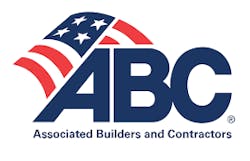ABC: 2021 Recovery Takes Likely 'W' Shape Amid Recession Fears
PRESS RELEASE
WASHINGTON, DC, Dec. 15, 2020 — Associated Builders and Contractors' Chief Economist Anirban Basu forecasts a recession threat for the construction sector next year, but has illuminated some potential economic bright spots, such as e-commerce and Class B office space, according to a 2021 economic outlook published in ABC's Construction Executive magazine.
Although ABC’s Construction Backlog Indicator—a leading indicator that reflects projects under contract yet to be executed—rebounded to 7.7 months in October, an increase of 0.2 months from September 2020’s reading, and although construction had added 689,000 jobs by September (after a loss of 1.1 million in March and April), Basu indicates that another surge of case numbers paired with a lack of new stimuli from Congress, as well as supply difficulties—such as increasing softwood lumber and steel prices—will likely result in a “W” shaped recovery.
“Another recession may be on the horizon,” Basu said. “Critically, one could occur even if a further stimulus is passed. Stimulus supports the demand side of the economy, primarily. Another shutdown would compromise the economy’s ability to produce (supply side), presumably leading to another round of mass layoffs, job loss, crumbling consumer confidence, corporate bankruptcies and other negative outcomes. If the first recession is any indication, the next one will be sharp and short. Regardless, that would delay complete recovery, which is the ultimate aspiration.”
These factors have pushed nonresidential construction to the brink. Commercial real estate, Basu determines, is particularly on the outs because the majority of the American workforce has abandoned Class A office spaces for their homes. In fact, the negation of commutes, childcare concerns and office distractions have meant that 37% of workers now complete their jobs entirely from home.
“Survey data indicates that lending to commercial real estate ventures has tightened, while state and local government finances have been compromised, especially in states that depend upon substantial tourism activity,” Basu said. “This only adds to the simmering uncertainty that lingers, resulting in less risk-taking among developers and others who procure nonresidential construction services. Nonresidential construction employment is down almost 6% on a year-ago basis as winter approaches.”
Basu also notes that backlog data has been receding, with some contractors indicating that they will exhaust current backlog by year’s end. And, according to ABC’s November Construction Confidence Index, the readings for sales, profit margins and staffing levels once again decreased, although staffing levels remained above the threshold of 50, indicating expectations of expansion over the next six months.
“Even with all these negative signs in the construction market, there are some bright spots,” Basu said. “One segment that has benefited from the shutdowns and social distancing measures is e-commerce.”
To read the full economic outlook, visit ConstructionExec.com.
MEMBERS SAW BACKLOGS SHRINK IN NOVEMBER
On Dec. 8, ABC reported that its Construction Backlog Indicator had declined to 7.2 months in November, a decrease of 0.5 months from October, according to an ABC member survey conducted from Nov. 20 to Dec. 2. Backlog is 1.7 months lower than in November 2019.
ABC’s Construction Confidence Index readings for sales, profit margins and staffing levels decreased in November. The staffing levels index reading remained above the threshold of 50, indicating expectations of expansion over the next six months. The index reading for sales dipped below 50 in November, while the profit margin index reading remained beneath that threshold, indicating expectations of contraction.
“When the pandemic first struck down the economic expansion during the February-April timeframe, construction emerged as a relative bulwark of stability,” said Basu. “The sector’s essential industry status in most parts of the country, combined with significant pre-existing backlog, allowed much of industry’s activity to persist even as restaurant, retail, hotel, transportation, tourism and other segments suffered massive setbacks. But the protective shields that helped sustain industry performance have begun to weaken.
“Many projects have been postponed, while others have been cancelled,” said Basu. “New bidding opportunities have become rarer, helping to push backlog lower. The p of prospect of additional lockdowns hasn’t helped, with many investors remaining too uncertain to bring the next generation of commercial projects to market. Lending conditions have tightened. Many segments have been battered financially, including healthcare, certain manufacturing sectors and lodging. A number of contractors also report project delivery interruptions as workers become infected. That has helped to dampen confidence, with contractors collectively indicating expectations for lower sales and profit margins over the next six months. At the same time, the emergence of vaccine candidates provides light at the end of the tunnel, but 2021 is shaping up to be a challenging year for many contractors.”
Click here for historical CCI and CBI data and here for methodology.
Note: The reference months for the Construction Backlog Indicator and Construction Confidence Index data series were revised on May 12, 2020, to better reflect the survey period. CBI quantifies the previous month’s work under contract based on the latest financials available, while CCI measures contractors’ outlook for the next six months.
